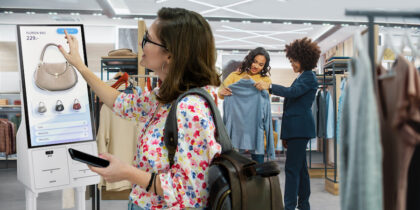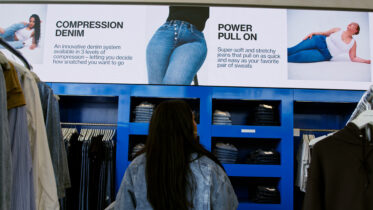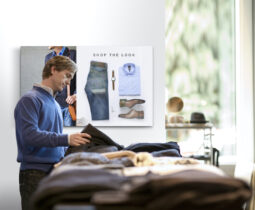It’s no secret that online shopping’s impact on retail has been profound. Gains in retail revenue in the past few years have been driven almost entirely by online channels, which are growing up to 7 percent faster than the retail sector as a whole, according to PwC. In the U.S., 37 percent of consumers say they shop less often at retail stores because of online stores.
Brick and mortar retailers’ top counter-strategy is to lure customers back by offering in-store retail experiences that can’t be matched on a screen or phone. To get there, savvy retailers are pulling out all the stops, blending their inherent advantages — real human attention and the ability to touch and feel merchandise — with everything technology has to offer. That combination can foster a super-charged, engaging, personalized in-store experience that has customers spending more, coming back often and telling their friends.
Assisted selling is a major component of this strategy for high-touch retailers, harnessing everything a retailer knows about an individual customer to craft a relevant, personalized experience. Using mobile devices, associates can connect customers with a wide range of data-fueled services and assistance.
Tech-Fueled Retail Experience
Online shopping leaders pioneered data-driven personalization, steadily ratcheting up their ability to collect and leverage individual customer behavior data to drive an increasingly personalized customer experience. It was difficult for physical retailers to match that, due to a lack of visibility into what each consumer does inside the store. But now, technology — mobile devices, IOT, GPS, artificial intelligence, in-store analytics, robotics and more — can finally fill those gaps.
It’s now up to retailers to apply those tools intelligently to achieve their desired brand experience and reap the rewards.
The power of combining technology and great in-store experiences isn’t just conjecture. According to BRP, 32 percent of consumers feel personal experiences are missing from their current in-store experiences. A tech-enabled personalized experience changes that. Other insights from the report include:
- 49 percent of shoppers are extremely likely to buy if helped by a knowledgeable associate; another 39 percent are somewhat likely
- 49 percent would be willing to pay more for products if they had a highly personalized in-store experience
- 57 percent of shoppers felt they received prompt, personal service when they knew that store associates were collaborating on mobile devices such as tablets and smartphones to help them
Consumers’ daily interactions with powerful apps that fulfill their wants and needs at the touch of a finger have primed them to expect engaging, mobile-enabled experiences in the store.
Bringing Data to Bear for Assistive Selling
The point where a customer with an interest or need encounters an associate armed with the right tools and data is where retailers can see their visions for standout in-store experiences come to life.
It all starts with that vision. Every retailer needs to define for itself what that ideal customer encounter should look like. Then it’s time to make it a reality by establishing the platform that will make it possible: data, tools, analytics and other applications, as well as the right practices, processes and permissions. Access to a real-time, 360-degree view of the customer is essential to deliver a deeply individualized experience that truly adds value; assistive selling applications need to be able to leverage the insights they have just collected.
Create the Shopping Experience of the Future
This guide explains how IoT tools can close the gaps in your omnichannel retail strategy. Download Now
Mobile devices including smartphones, wearables and tablets are key to delivering the in-store personalization vision for most retailers. Here are a few of the ways they can be used to improve the retail experience:
Predictive Assistance/Clienteling Tools: Associates greet customers and leverage personalized data including preferences, history and recent activity in-store and online to anticipate what the customer might be looking for. Real-time, in-store analytics ensure associates are accessing the latest knowledge about that customer’s activity.
Endless Aisle: Together, customer and associate can browse for extended sizes, colors or accessories, and select items for direct shipping or store pick-up. They can also explore items the customer recently considered online.
Virtual Dressing Room: By capturing images of the customer in the store and feeding them to augmented reality applications viewable on the mobile device, the customer can virtually try a number of items before taking the best ones to the real dressing room to confirm the fit.
Tailored Promotions: Real-time analysis and profiling can also be used to push prompts to the associate to point out other products in the store that are best-suited for each customer.
Inventory Location: Associates can locate desired inventory, whether it’s in the store, or in another store or warehouse.
Mobile POS: The associate can complete transactions on the spot with optimal speed and convenience, while gathering data that helps the store enhance personalization going forward.
Social Media Integration: Depending on the engagement strategies they choose, retailers might also capture images and clips of the customer to be shared on social media.
Achieving the Vision
Retailers are working aggressively toward adding or enhancing their use of assisted selling tools to support their customer engagement goals. The same BRP survey found 62 percent of retailers saying customer identification is their top customer engagement priority, 38 percent are prioritizing real-time retail (disseminating data across retail channels in real time), and 83 percent will suggestive sell based on previous purchases within three years.
Mobile devices are a key enabler; that’s why 51 percent are prioritizing the empowering of associates with mobile tools as a customer engagement priority. The right mobile device enables retailers to infuse the in-store experience with digital capabilities like real-time in-store analytics that transform ordinary in-store experiences into deeply personalized, highly engaging brand experiences.
Looking for more cutting-edge retail solutions? Check out our full line of innovative retail technology.








